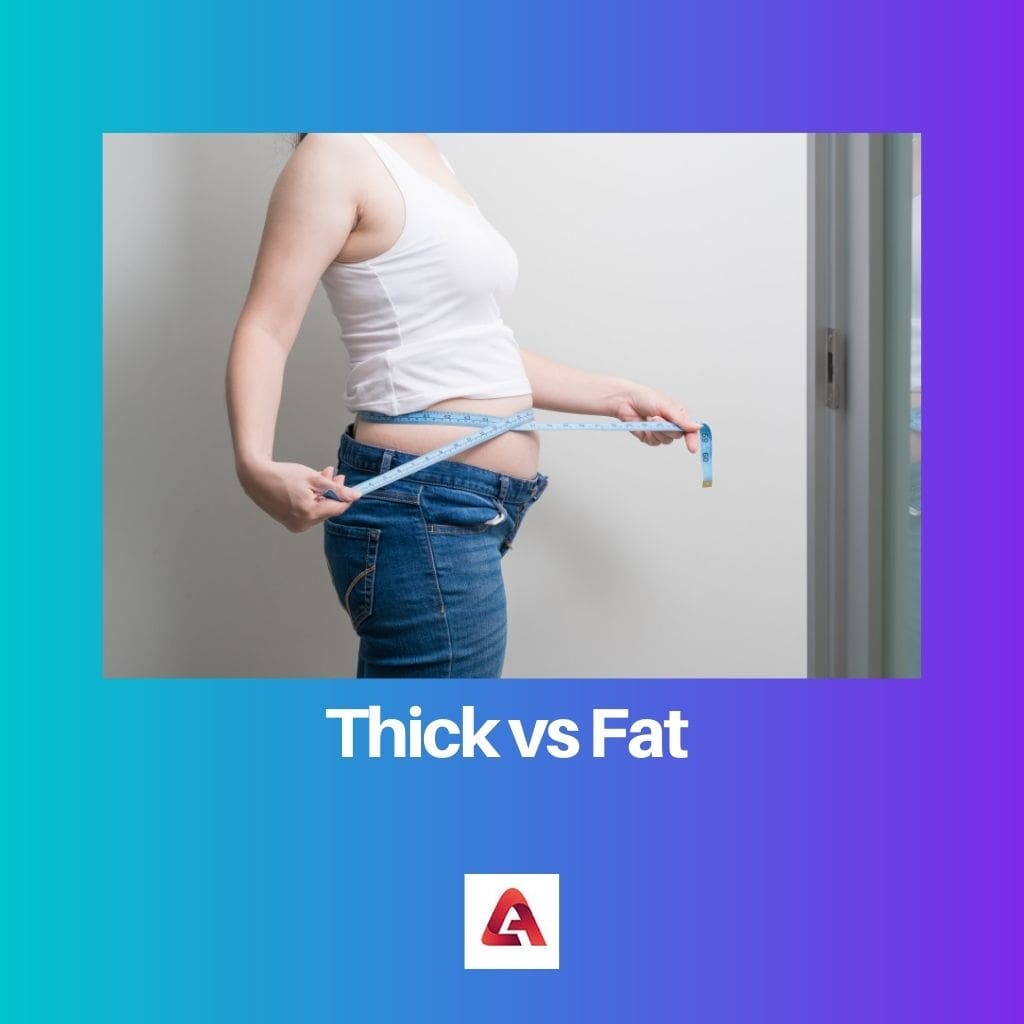When describing a person’s appearance, the words slim, thin, lean, healthy, thick, fat, etc are used. Each of these words has a different meaning, and each of them represents a different appearance.
Words like thick and fat are synonymous but have different meanings and representations.
Key Takeaways
- Thick is an adjective that describes measuring an object or substance from one side to the opposite, implying a substantial dimension.
- Fat is the natural oily or greasy substance occurring in animal bodies, stored as an energy reserve and essential for various bodily functions.
- The main difference between thick and fat is their context of use: thick is a general term related to dimensions, while fat specifically relates to a biological substance.
Thick vs. Fat
Thickness is a term used to describe an object that is substantial or solid or a person with a muscular or sturdy build. Fat is an excessive amount of body weight or mass, used to describe someone who is overweight or obese or an object that is bulky or cumbersome.

The word thick is used to represent a person with a larger or above-average size. However, the word thick is taken in a positive sense. The word fat represents a person with a lot of loose and excess flesh; the word is taken negatively or insultingly.
Comparison Table
| Parameter of Comparison | Thick | Fat |
|---|---|---|
| Basic meaning | In describing a person’s appearance, the word thick describes an above-average-sized person. | In the context of describing appearances, the word fat is used to represent a person with an excess amount of flesh which is loose. |
| Representation of what type of connotation | People use to associate the word thick with a positive connotation. It is taken as a compliment. | People associate the word fat with a negative connotation and consider it an insult. |
| Characteristics | A slim waistline, thicker breasts, and a lower body portion characterize a thick person. | A large or fatty stomach, fat thighs, upper arms, and the loose skin of arms, legs, and sides of the body characterize a fat person. |
| Point of View | There is no general point of view of a thick person’s appearance. | The general point of view of people towards fat people is that they consider them as unattractive and ugly. People think that fat people are at higher risk of getting chronic diseases. |
| Usage | The word thick is used to represent someone’s appearance, especially females. | The word fat is used to denote or represent an obese or overweight person. |
What is Thick?
Thick is an adjective that defines the quality of being thick. In describing appearances, thick is used to represent or denote a person with a size greater than the average.
Generally, this word is used to describe the appearance of females. The word is considered positive, and this one takes it as a compliment.
People do not get offended when they are called thick. Some of the characteristics of thick persons include a slim waistline, thicker breasts, a thicker lower portion of the body, etc.
Such characteristics of the body make it look like a pear. Therefore, the shape is named a pear-shaped body.
There is no general point of view associated with thick people. Thick people are considered to be healthy or physically fit.

What is Fat?
Fat is an adjective that defines a quality. In describing appearances, the word fat is used to represent a person with an excess amount of fat bulging out from his body.
It defines obese and overweight people. This word is considered inferior and associated with a negative connotation.
If a person is called fat, he or she feels insulted. Fat characteristics include a fatty stomach, fat thighs and upper arms, loose skin of arms, legs, and on the sides of the body, etc.
Their fat bulges out of the body. These characteristics make a body look like an apple. Therefore, this shape of the body is termed an apple-shaped body.
Fat people are called as being unattractive or ugly and are looked at as being unhealthy. Being fat has several associated health risks, such as heart disease, strokes, high blood pressure, diabetes, etc.

Main Differences Between Thick and Fat
- When describing a person’s appearance, the word thick is used to represent the person having a size above average; on the other hand, the word fat is used to represent a person having an excess amount of loose flesh.
- The word thick is used to represent a person’s appearance, females, whereas fat represents an obese or overweight person.
- People associate the word thick with a positive connotation, whereas fat is associated with a negative connotation.
- People take the word thick as a compliment; on the other hand, people take the word fat as an insult.
- A thick person has a slimmer waistline but a thicker breast and lower portion of the body, while a fat person has a large stomach, fat in arms and legs, loss of skin, etc.
- The shape of a thick person’s body is termed a pear-shaped body; on the other hand, the body shape of a fat person is termed an Apple shape.
- People think a fat person is unattractive or ugly, while no such general view is associated with a thick person.
- There are several health risks associated with being fat, while a thick person has fewer health risks.

- https://www.cambridge.org/core/journals/british-journal-of-nutrition/article/assessment-of-the-amount-of-fat-in-the-human-body-from-measurements-of-skinfold-thickness/DA80501B784742B9B2F4F454BDEE923B
- https://www.cambridge.org/core/journals/british-journal-of-nutrition/article/assessment-of-the-amount-of-fat-in-the-human-body-from-measurements-of-skinfold-thickness/DA80501B784742B9B2F4F454BDEE923B

This article is eye-opening, I had never thought about the differences so deeply.
I believe the article does a great job at presenting these terms in an intellectual and respectful manner.
I agree, it does so without being judgmental.
I’m happy to see an article that addresses these distinctions. The topic is important and relevant.
This article shines light on the complexity and nuances of these oftentimes misunderstood terms.
Yes, it offers a thorough exploration of the topic.
It’s refreshing to have clarity on this subject.
The article is very comprehensive and gives a clear distinction between thick and fat. Interesting read.
Yes, it’s important to understand how we use these words.
I found it really interesting too.
This article is quite helpful to understand how these words can be perceived by different people.
I never considered this topic, but this article provides a good analysis.
Yes, it’s insightful to reflect on the connotations of these words.
The article is an interesting and insightful analysis of the distinctions between ‘thick’ and ‘fat’.
It is indeed very thorough.
Absolutely, it’s a valuable resource.
The concept of body shaming is still very present nowadays. This article contributes to clarify that this distinction is real and shows the importance of using these words carefully.
Yes, it’s crucial to be respectful and mindful of people’s feelings.
Agree, it’s really important to be aware of the implications of the words we use.
I strongly disagree with the way this article portrays the word ‘fat’. It feels judgemental and divisive.
I agree, this is enforcing stereotypes.
I see your point, it could have included a more neutral view of the word.
Great! This article is very informative and it made me understand better the difference between these two words. I’ve always used them synonymously.
I also thought these words were the same and now I understand the distinction.